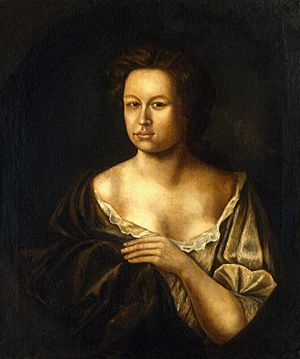Mary Pix facts for kids
Mary Pix (born in 1666, died May 17, 1709) was an English writer who wrote novels and plays. She admired Aphra Behn and worked with Susanna Centlivre. People often see Pix as an important link between women writers from the Restoration period and the Augustan age.
Contents
Mary Pix's Early Life
Mary Griffith Pix was born in 1666. Her father, Roger Griffith, was a rector, musician, and the headmaster of the Royal Latin School in Buckingham, Buckinghamshire. Mary's father passed away when she was very young. However, Mary and her mother continued to live in the schoolhouse after his death.
In 1684, when Mary was 18, she married George Pix. He was a merchant tailor from Hawkhurst, Kent. The couple moved to his family's estate in Kent. Their first son, George, was born in 1689 but sadly died very young in 1690. The next year, Mary and George moved to London. There, Mary gave birth to another son, William, in 1691.
Mary Pix's Writing Career
In 1696, when Mary Pix was thirty years old, she started her career as a professional writer. She published her first and only novel, The Inhumane Cardinal; or, Innocence Betrayed. In the same year, she also released two plays: Ibrahim, the Thirteenth Emperour of the Turks and The Spanish Wives.
Mary Pix quickly became known alongside two other female playwrights. These were Delariviere Manley and Catherine Trotter. All three women became quite successful. Their success led to them being criticized in a funny, anonymous play called The Female Wits (1696). In this play, Mary Pix was shown as "Mrs. Wellfed." She was described as a friendly, good-natured, and somewhat naive woman.
Her first play was performed in 1696 at the Theatre Royal, Drury Lane in London. This theater was close to her home. However, when the same theater company performed The Female Wits, she moved her plays to Lincoln's Inn Fields. People said she was brave to show her writing talent. They also noted that she found success, even if it didn't make her much money.
Plagiarism Scandal
During the 1697–1698 theater season, Mary Pix was involved in a plagiarism scandal. This happened with George Powell, who was a rival playwright and manager of the Drury Lane theater company. Pix sent her play, The Deceiver Deceived, to Powell's company. She hoped they would perform it.
Powell rejected her play but kept the manuscript. He then wrote and performed his own play called The Imposture Defeated. This play had a plot and main character taken directly from Pix's work. Mary Pix publicly accused Powell of stealing her ideas. Powell claimed they both got their ideas from the same unnamed novel.
An anonymous writer, now thought to be Powell, published a letter in 1698. This letter attacked Pix and Catherine Trotter. It tried to make fun of Pix's spelling and her courage in publishing her writing. Even though her public reputation wasn't harmed, Pix stopped putting her name on her plays after 1699. She only put her name on one more play after that. However, many believe she wrote at least seven more plays anonymously.
Women Writers of Her Time
Most female playwrights during Mary Pix's era did not come from a theater background. They also were not from noble families. Later, in the 18th century, many successful actresses and female authors came from families already involved in literature and theater. But Mary Pix and her fellow writers were different. They came from outside this world. They had little in common except a love for writing and a middle-class background.
During the time of Mary Pix, it was common for both husbands and wives to work together. They often ran family businesses to support themselves. This was different from the 18th century, when women usually stayed home to care for the family. Female playwrights in Pix's time also earned the same amount of money as their male counterparts.
Also, authors' names were not always advertised on playbills or printed plays. This made it easier for female authors to hide their identity. This helped their plays be more easily accepted by audiences who might have been more traditional. Plays were judged by how well they performed, not by who wrote them. This meant that female playwrights competed equally with male writers.
Mary Pix published A Poem, Humbly Inscrib'd to the Lords Commissioners for the Union of the Two Kingdoms in May 1707. This was her last published work. She passed away two years later in 1709.
Mary Pix's Works
Mary Pix wrote one novel and seven plays that are known to be hers. There are also four other plays published without her name that are generally thought to be written by her.
Novels
- The Inhumane Cardinal; or, Innocence Betrayed (1696)
Plays
- Ibrahim, the Thirteenth Emperor of the Turks (1696)
- The Spanish Wives (1696)
- The Innocent Mistress (1697)
- The Deceiver Deceived (1697)
- Queen Catharine; or, The Ruines of Love (1698)
- The False Friend; or, the Fate of Disobedience (1699)
- The Beau Defeated; or, the Lucky Younger Brother (1700)
- The Double Distress (1701)
- The Czar of Muscovy (1701) – (thought to be by Pix, but not published with her name)
- The Different Widows; or, Intrigue All-A-Mode (1703) – (thought to be by Pix)
- Zelmane; or, the Corinthian Queen (1705) – (thought to be by Pix, but some scholars still discuss this)
- The Conquest of Spain (1705) – (thought to be by Pix)
- Adventures in Madrid (1706) – (thought to be by Pix)
Poetry
- Violenta; or, The Rewards of Virtue, Turn'd from Boccace into Verse (1704)
See also
- Fop



